-
CATEGORY ::
- All Seeds /
- All Flower Seeds /
- All Viola Seeds







Viola Seeds - Johnny Jump Up
SEEDS PER POUND
405,000
SEASON
Perennial
USDA ZONES
3 - 9
HEIGHT
6 inches
BLOOM SEASON
Spring through fall
BLOOM COLOR
Mix
ENVIRONMENT
Full sun to partial shade
SOIL TYPE
Rich, well-drained, pH 5.8 - 6.8
DEER RESISTANT
No
HOUSE PLANT
Yes
SEASON
Biennial
USDA ZONES
5 - 9
HEIGHT
6 - 8 inches
BLOOM SEASON
Spring, fall
BLOOM COLOR
Mix
ENVIRONMENT
Full sun to partial shade
SOIL TYPE
Average garden soil, pH 5.8 - 7.2
DEER RESISTANT
No
HOUSE PLANT
Yes
SEASON
Biennial
USDA ZONES
5 - 9
HEIGHT
6 - 8 inches
BLOOM SEASON
Spring, fall
BLOOM COLOR
Raspberry
ENVIRONMENT
Full sun to partial shade
SOIL TYPE
Average garden soil, pH 5.8 - 7.2
DEER RESISTANT
No
HOUSE PLANT
Yes
SEASON
Biennial
USDA ZONES
5 - 9
HEIGHT
6 - 8 inches
BLOOM SEASON
Spring, fall
BLOOM COLOR
Mix
ENVIRONMENT
Full sun to partial shade
SOIL TYPE
Average garden soil, pH 5.8 - 7.2
DEER RESISTANT
No
HOUSE PLANT
Yes
SEASON
Biennial
USDA ZONES
5 - 9
HEIGHT
5 inches
BLOOM SEASON
Spring, fall
BLOOM COLOR
Purple
ENVIRONMENT
Full sun to partial shade
SOIL TYPE
Average garden soil, pH 5.2 - 6.2
DEER RESISTANT
No
HOUSE PLANT
Yes
SEASON
Biennial
USDA ZONES
5 - 9
HEIGHT
6 - 9 inches
BLOOM SEASON
Spring and summer
BLOOM COLOR
Purple
ENVIRONMENT
Full sun to partial shade
SOIL TYPE
Average garden soil, pH 5.8 - 7.2
DEER RESISTANT
No
HOUSE PLANT
Yes
SEASON
Biennial
USDA ZONES
5 - 9
HEIGHT
8 inches
BLOOM SEASON
Spring, fall
BLOOM COLOR
Lavender
ENVIRONMENT
Full sun to partial shade
SOIL TYPE
Average garden soil, pH 5.5 - 5.8
DEER RESISTANT
No
HOUSE PLANT
Yes
SEASON
Biennial
USDA ZONES
5 - 9
HEIGHT
8 inches
BLOOM SEASON
Spring, fall
BLOOM COLOR
Mix
ENVIRONMENT
Full sun to partial shade
SOIL TYPE
Average garden soil, pH 5.5 - 5.8
DEER RESISTANT
No
HOUSE PLANT
Yes
About...
Johnny Jump-up (Viola cornuta) - These are such delightful little flowers that bring charm and grace to any summer landscape. They grow very easily from Viola seeds, and once established will even self-sow. They are not invasive just delightful!MORE VIOLA OPTIONS
Planting Directions
TEMPERATURE
65 - 75F
AVERAGE GERM TIME
14 - 21 days
LIGHT REQUIRED
Yes
DEPTH
Seeds must be covered thinly, no more than the thickness of the seed
SOWING RATE
3 ounces per 1,000 square feet or 7 pounds per acre
MOISTURE
Keep seed moist until germination
PLANT SPACING
6 inches
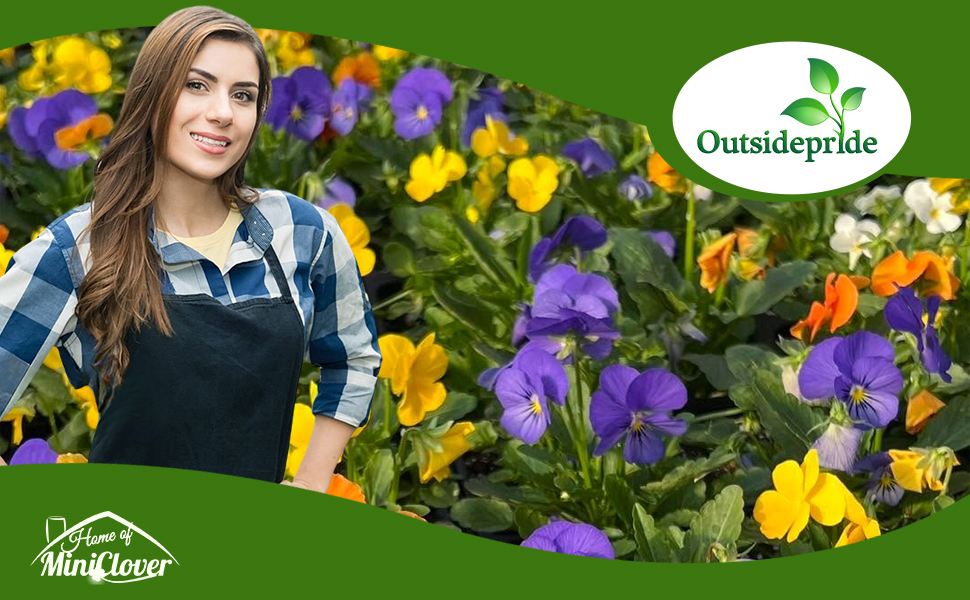
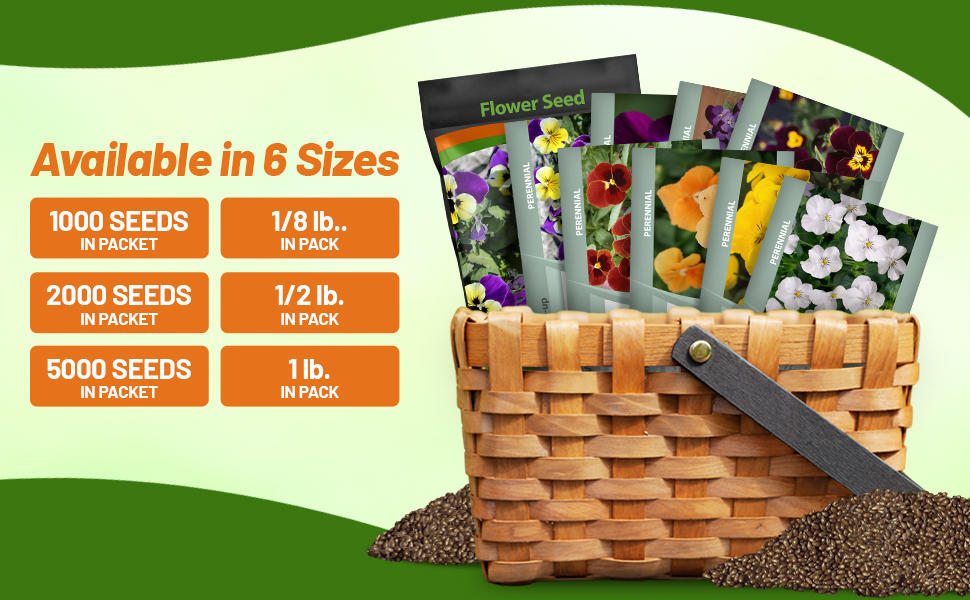
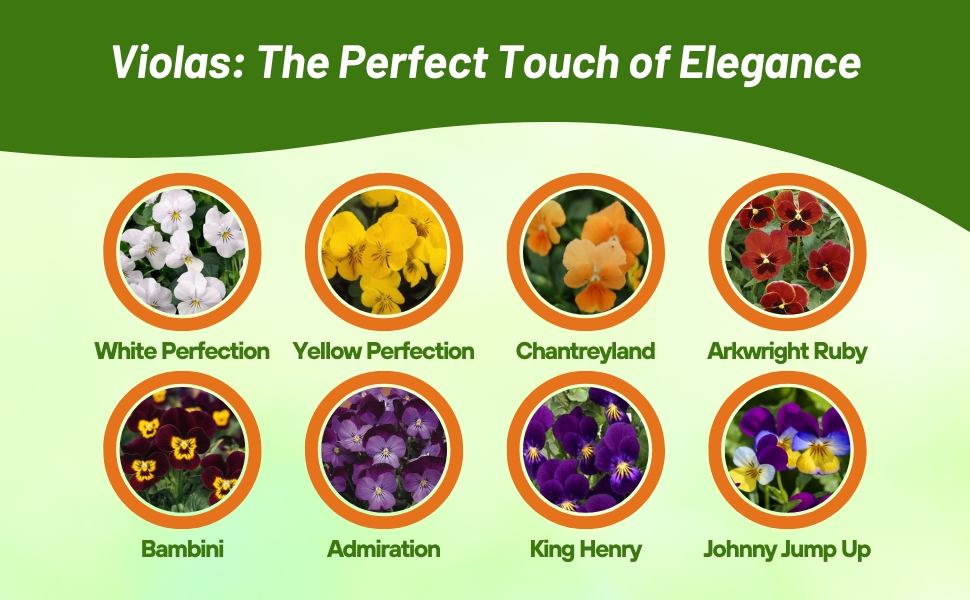
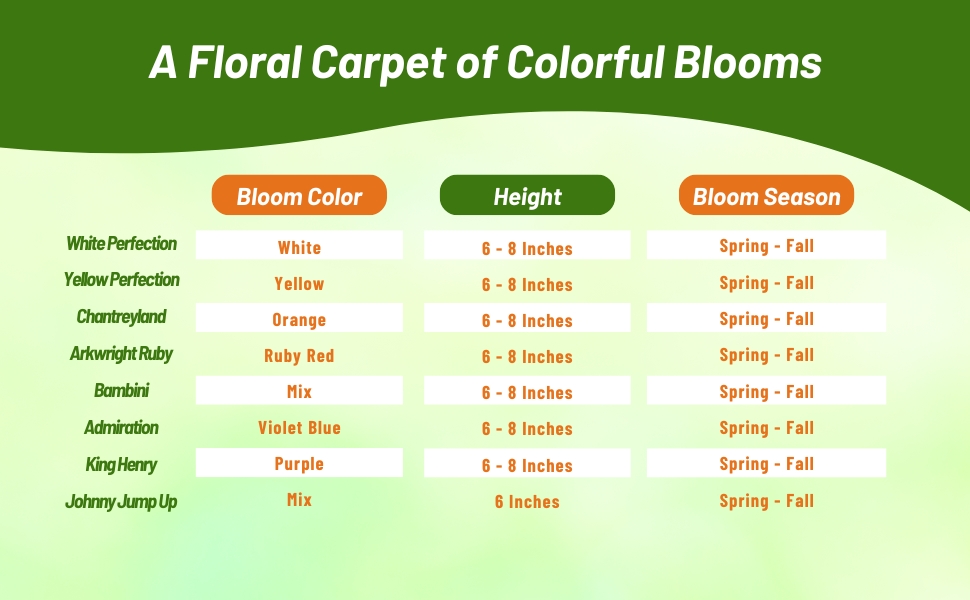
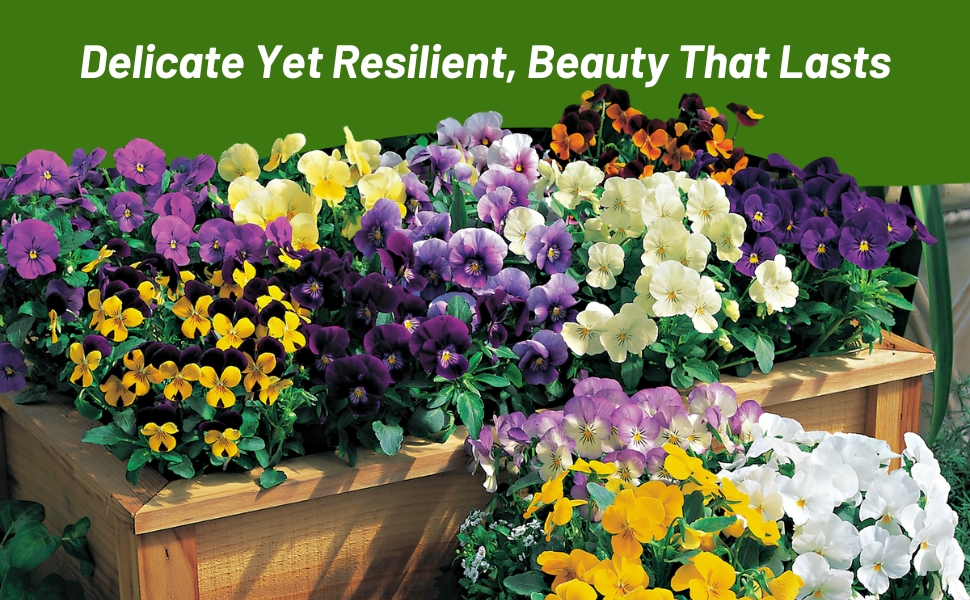
Johnny Jump-up (Viola cornuta) - These are such delightful little flowers that bring charm and grace to any summer landscape. They grow very easily from Viola seeds, and once established will even self-sow. They are not invasive just delightful! Johnny Jump Up wildflowers have been around for centuries and are native to the mountains of Spain and France. They are found growing in many temperate regions of the world, and they are widely admired for their bright little faces. Other common names you may have heard for this flower are Wild Pansy and Heartsease. Since they are cool weather flowers, Johnny Jump Up wildflowers will bloom in the spring, fade during the heat of summer, and will often return with a new flush of flowers in the fall.
Common Questions
Are pansies edible?
Yes, they have a mild minty taste and may be eaten fresh as a garnish or candied for decorating cakes.
Why do my pansies stop blooming in the summer?
Hot weather will cause pansies to fade and die out.
Why are my pansies spindly?
Check to see if your plants are overcrowded, pansies need to be spaced 6 inches apart. Make sure they are getting enough light especially when starting seeds inside.
Should pansies be deadheaded?
Yes, to encourage a longer bloom season you will need to deadhead your flowers. This will also keep the flowers from dropping seeds.
When do pansies bloom?
Pansies bloom in the fall and in spring into early summer when the weather is cool.
Do pansies grow better in containers or in the ground?
Pansies flourish in both pots and raised beds. Because they have shallow roots, it's important not to plant them too deeply in dense soil. Always opt for well-draining soil for beds and a light potting mix for containers, ensuring that the containers also have drainage holes.
Planting Directions
TEMPERATURE
65 - 70F
AVERAGE GERM TIME
7 - 21 days
LIGHT REQUIRED
No
DEPTH
Cover seed lightly with peat moss
SOWING RATE
3 - 4 seeds per plant
MOISTURE
Keep seeds moist until germination
PLANT SPACING
8 - 12 inches

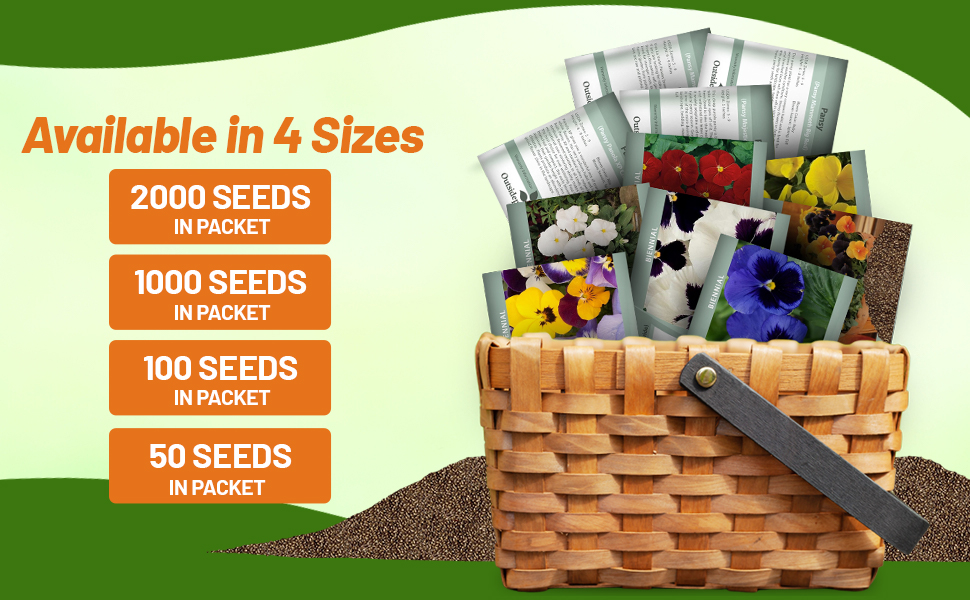

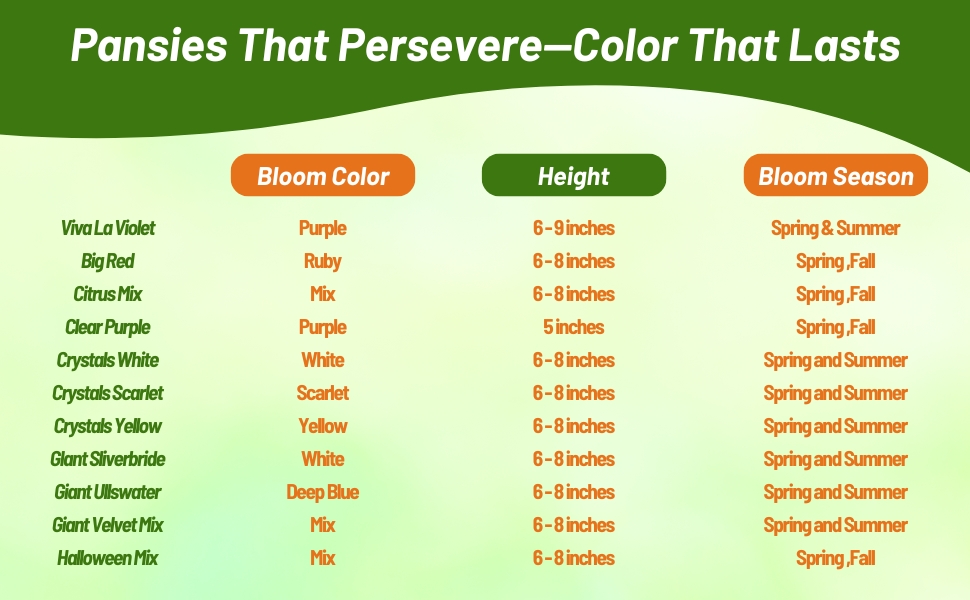

Pansy (Pansy Spooky Halloween Mix) - You may not have known it, but Pansies are the most sold flower in the world. There are two main types of pansies, clear or pure & faced or blotch. A pansy with a face/blotch, features a dark blotch in the center of the flower. Pansies are available in an amazing array of colors including this unique orange and black display. Pansy plants can overwinter in many areas if they had time to develop a good footing and are easy to grow for these raw, prime pansy seeds. Pansies rarely have any disease or insect problems making them very low maintenance. The Panola series of Pansy plants are a cross between a Pansy & Viola which results in medium sized flowers that hold up better in rain and snow than the much larger flowering pansy varieties.
Common Questions
Are pansies edible?
Yes, they have a mild minty taste and may be eaten fresh as a garnish or candied for decorating cakes.
Why do my pansies stop blooming in the summer?
Hot weather will cause pansies to fade and die out.
Why are my pansies spindly?
Check to see if your plants are overcrowded, pansies need to be spaced 6 inches apart. Make sure they are getting enough light especially when starting seeds inside.
Should pansies be deadheaded?
Yes, to encourage a longer bloom season you will need to deadhead your flowers. This will also keep the flowers from dropping seeds.
When do pansies bloom?
Pansies bloom in the fall and in spring into early summer when the weather is cool.
Do pansies grow better in containers or in the ground?
Pansies flourish in both pots and raised beds. Because they have shallow roots, it's important not to plant them too deeply in dense soil. Always opt for well-draining soil for beds and a light potting mix for containers, ensuring that the containers also have drainage holes.
Planting Directions
TEMPERATURE
65 - 70F
AVERAGE GERM TIME
7 - 21 days
LIGHT REQUIRED
No
DEPTH
Cover seed lightly with peat moss
SOWING RATE
3 - 4 seeds per pl
MOISTURE
Keep seeds moist until germination
PLANT SPACING
6 - 8 inches
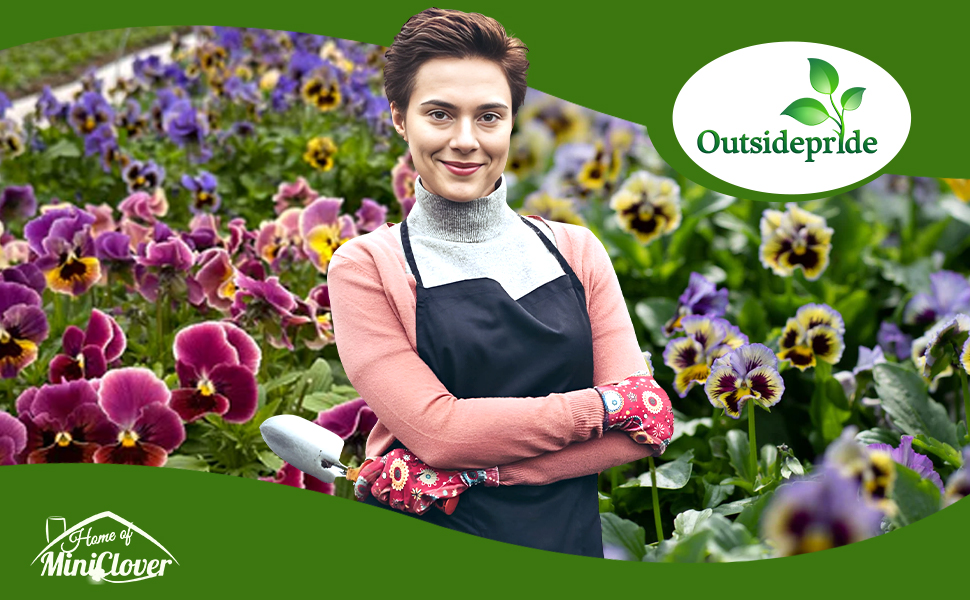

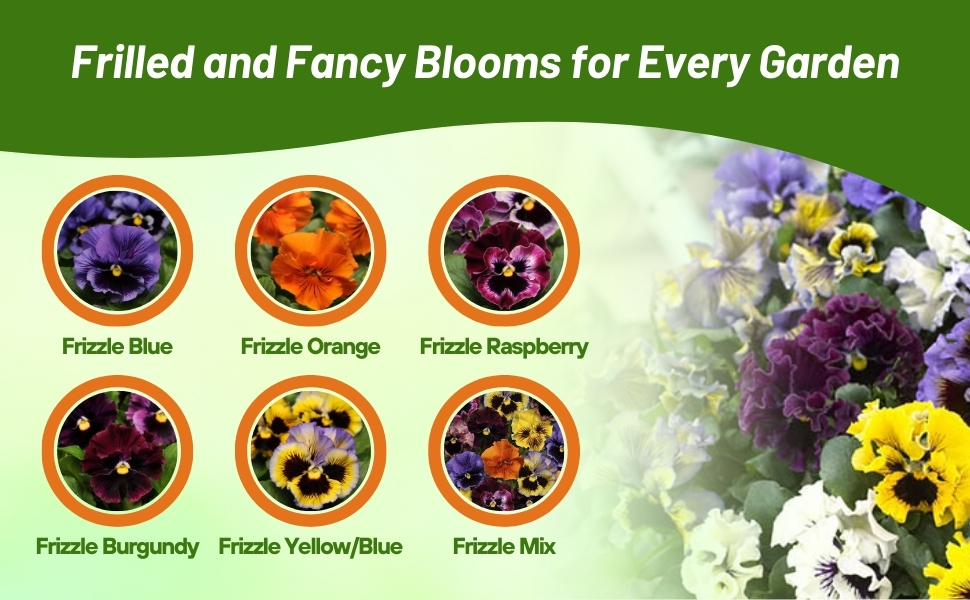
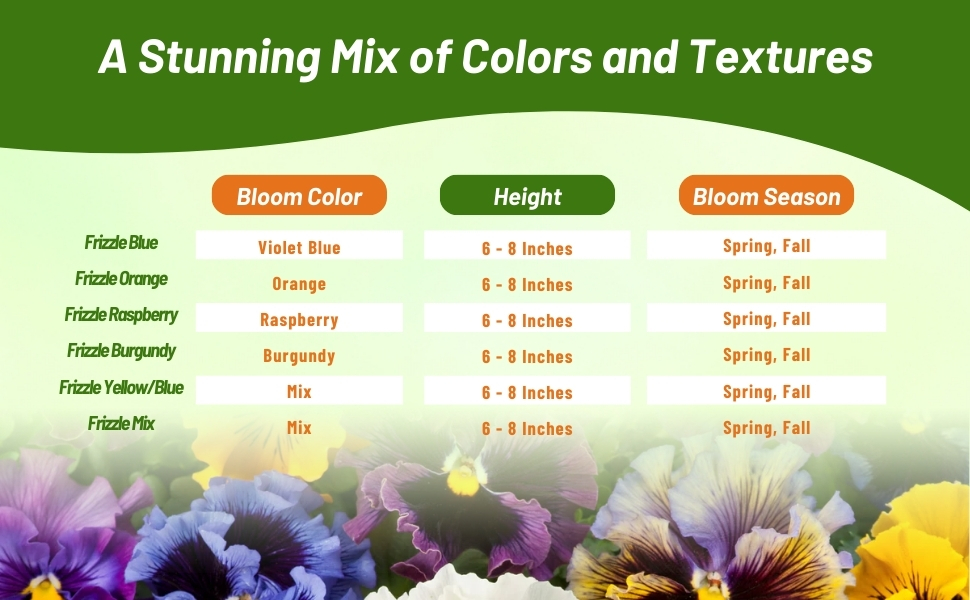

Pansy (Pansy Frizzle Sizzle Raspberry) - Pansy plants never looked so good as this Pansy Frizzle Sizzle Raspberry colored hybrid. Brilliant raspberry colored blossoms and frills that bring your garden to life during late winter and spring. Raspberry blooms on compact plants with a whiff of pansy fragrance and incredible flowering performance. If you want a ruffled looking Pansy, "Frizzle Sizzle" is ideal for brightening up your beds, containers, and window boxes. Grown from pansy seeds.
Common Questions
Are pansies edible?
Yes, they have a mild minty taste and may be eaten fresh as a garnish or candied for decorating cakes.
Why do my pansies stop blooming in the summer?
Hot weather will cause pansies to fade and die out.
Why are my pansies spindly?
Check to see if your plants are overcrowded, pansies need to be spaced 6 inches apart. Make sure they are getting enough light especially when starting seeds inside.
Should pansies be deadheaded?
Yes, to encourage a longer bloom season you will need to deadhead your flowers. This will also keep the flowers from dropping seeds.
When do pansies bloom?
Pansies bloom in the fall and in spring into early summer when the weather is cool.
Do pansies grow better in containers or in the ground?
Pansies flourish in both pots and raised beds. Because they have shallow roots, it's important not to plant them too deeply in dense soil. Always opt for well-draining soil for beds and a light potting mix for containers, ensuring that the containers also have drainage holes.
Planting Directions
TEMPERATURE
65 - 70F
AVERAGE GERM TIME
7 - 21 days
LIGHT REQUIRED
No
DEPTH
Cover seed lightly with peat moss
SOWING RATE
3 - 4 seeds per plant
MOISTURE
Keep seeds moist until germination
PLANT SPACING
6 - 8 inches
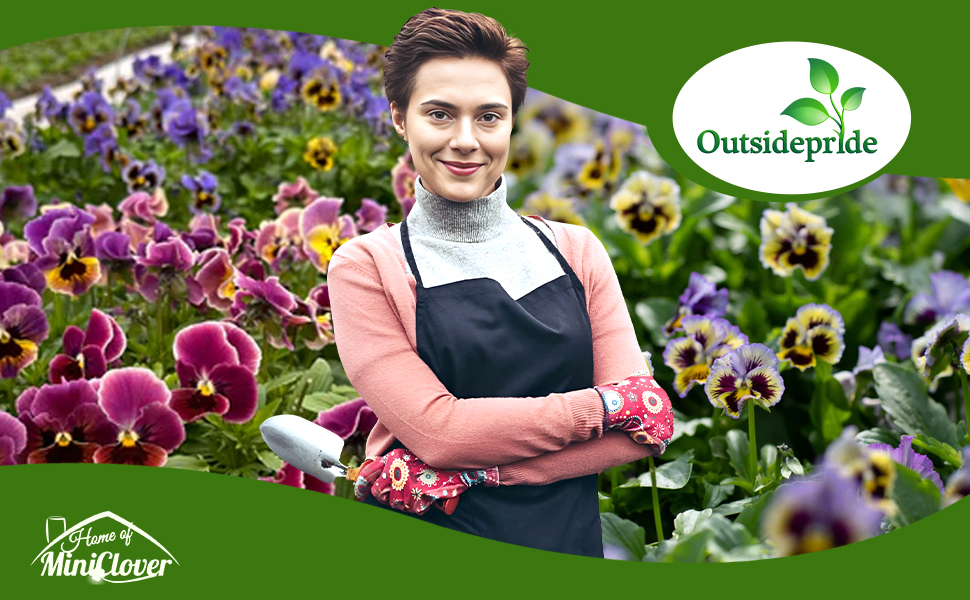


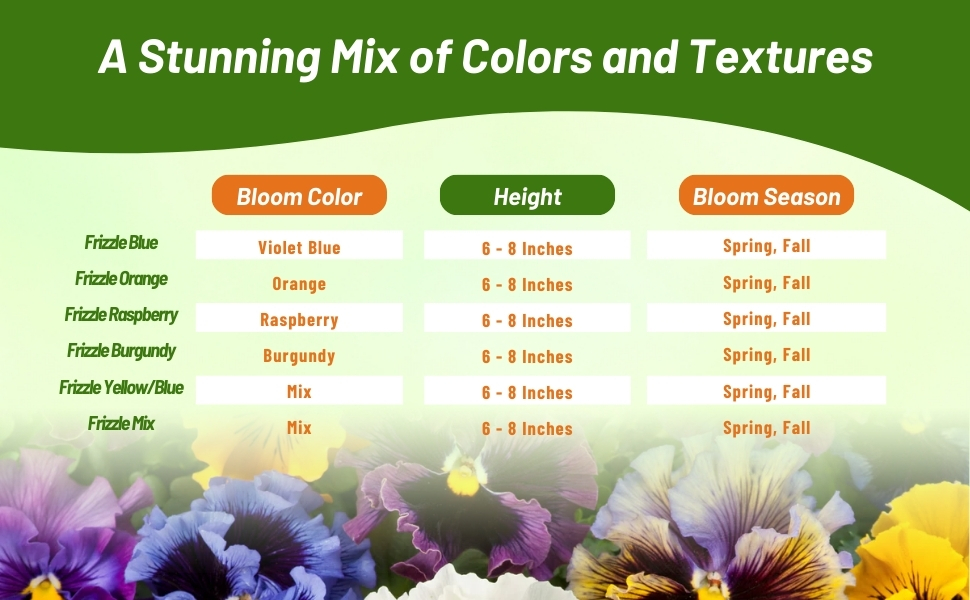
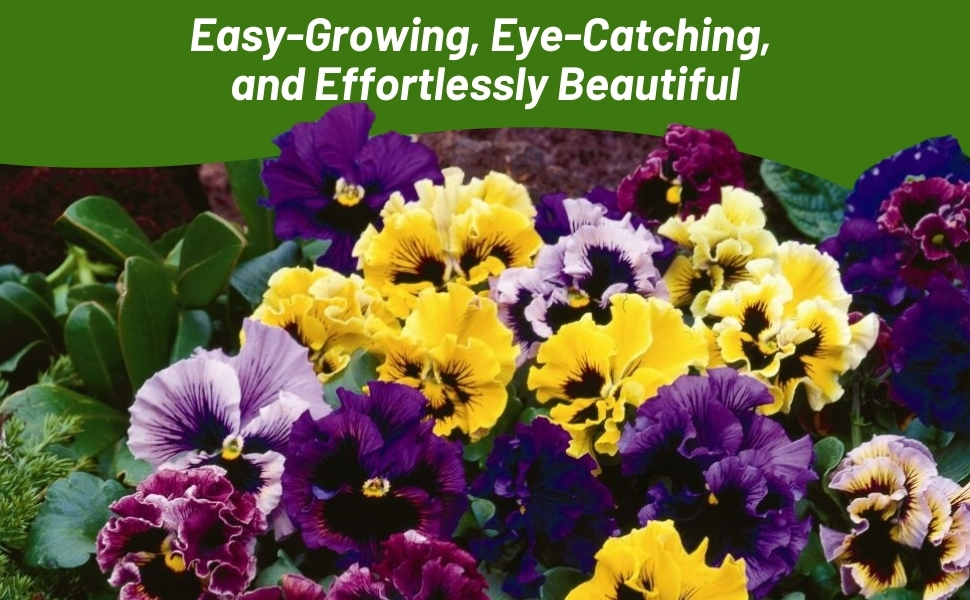
Pansy (Pansy Frizzle Sizzle Yellow/Blue Swirl) - Wow! The most unique combination of blue and yellow, a blotch center, combined with a cats whisker effect and ruffled edges gives you with the most unique variety of pansy available! Pansy Frizzle Swizzle Yellow/Blue Swirl is a combination of all the best features of any pansy plant available! The cats whisker effect together with the frilly, ruffled edge is perfect union of yellow and blue shades. This pansy plant, grown from pansy seeds, will add interest to your bedding throughout the spring until the summer bedding blooms.
Common Questions
Are pansies edible?
Yes, they have a mild minty taste and may be eaten fresh as a garnish or candied for decorating cakes.
Why do my pansies stop blooming in the summer?
Hot weather will cause pansies to fade and die out.
Why are my pansies spindly?
Check to see if your plants are overcrowded, pansies need to be spaced 6 inches apart. Make sure they are getting enough light especially when starting seeds inside.
Should pansies be deadheaded?
Yes, to encourage a longer bloom season you will need to deadhead your flowers. This will also keep the flowers from dropping seeds.
When do pansies bloom?
Pansies bloom in the fall and in spring into early summer when the weather is cool.
Do pansies grow better in containers or in the ground?
Pansies flourish in both pots and raised beds. Because they have shallow roots, it's important not to plant them too deeply in dense soil. Always opt for well-draining soil for beds and a light potting mix for containers, ensuring that the containers also have drainage holes.
Planting Directions
TEMPERATURE
59 - 64F
AVERAGE GERM TIME
14 - 21 days
LIGHT REQUIRED
No
DEPTH
Cover seed lightly with peat moss
SOWING RATE
3 - 4 seeds per plant
MOISTURE
Keep seeds moist until germination
PLANT SPACING
6 - 8 inches

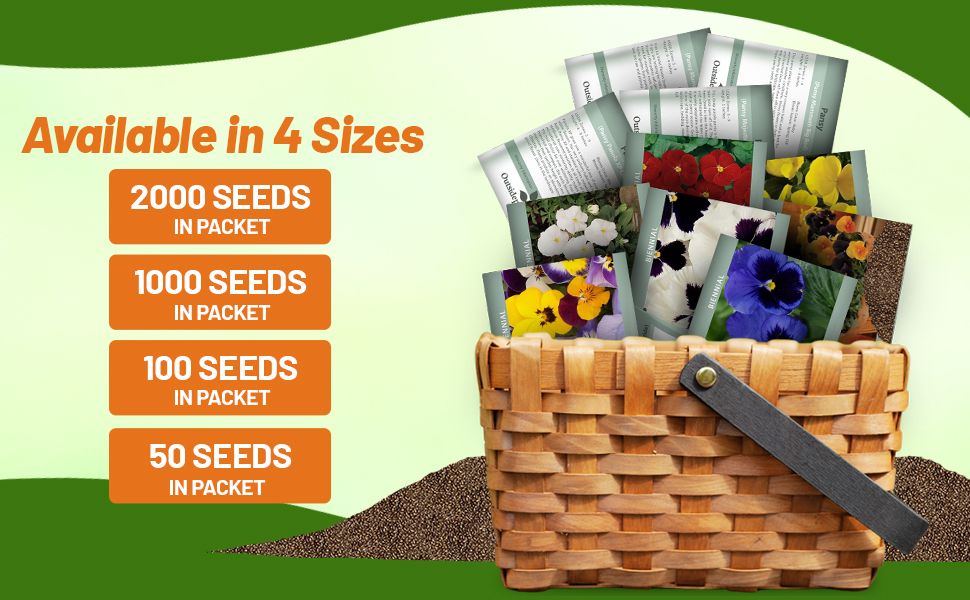

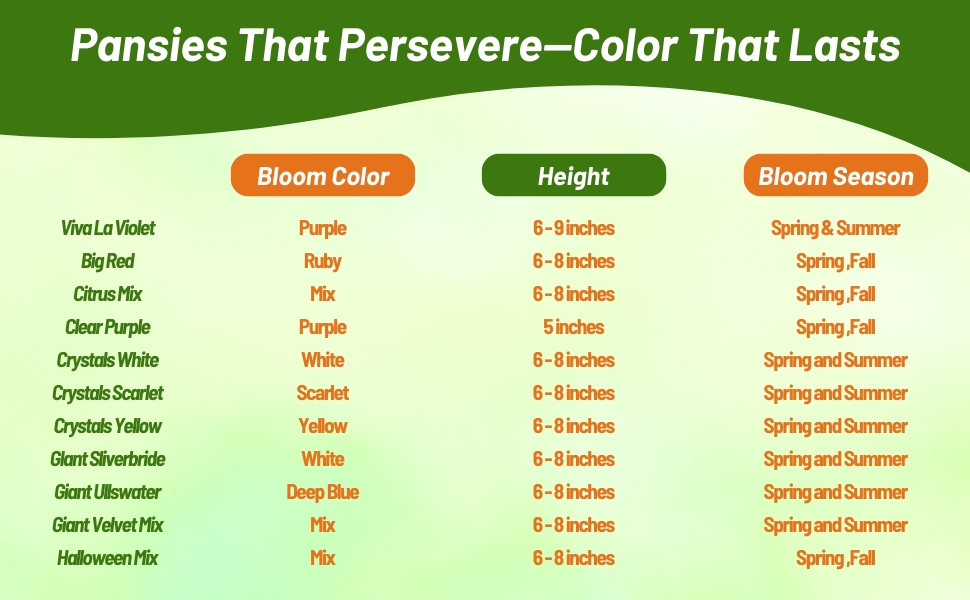

Pansy (Pansy Majestic Giants II Clear Purple) - This variety truly fits the person wanting a traditional solid color pansy. This deep purple pansy is beautiful and you won't want to take your eyes off of it. The Majestic Pansy varieties have been bred to take the heat of early fall pansy production and withstand the bitter cold northern winters, making it widely adaptable and extending its use beyond the typical pansy season. Grown easily from pansy seeds, it makes it one of the more desirable flower seeds available. For landscape, bedding, mixed containers in spring and fall.
Common Questions
Are pansies edible?
Yes, they have a mild minty taste and may be eaten fresh as a garnish or candied for decorating cakes.
Why do my pansies stop blooming in the summer?
Hot weather will cause pansies to fade and die out.
Why are my pansies spindly?
Check to see if your plants are overcrowded, pansies need to be spaced 6 inches apart. Make sure they are getting enough light especially when starting seeds inside.
Should pansies be deadheaded?
Yes, to encourage a longer bloom season you will need to deadhead your flowers. This will also keep the flowers from dropping seeds.
When do pansies bloom?
Pansies bloom in the fall and in spring into early summer when the weather is cool.
Do pansies grow better in containers or in the ground?
Pansies flourish in both pots and raised beds. Because they have shallow roots, it's important not to plant them too deeply in dense soil. Always opt for well-draining soil for beds and a light potting mix for containers, ensuring that the containers also have drainage holes.
Planting Directions
TEMPERATURE
65 - 70F
AVERAGE GERM TIME
7 - 21 days
LIGHT REQUIRED
No
DEPTH
Cover seed lightly with peat moss
SOWING RATE
3 - 4 seeds per plant
MOISTURE
Keep seeds moist until germination
PLANT SPACING
6 - 8 inches

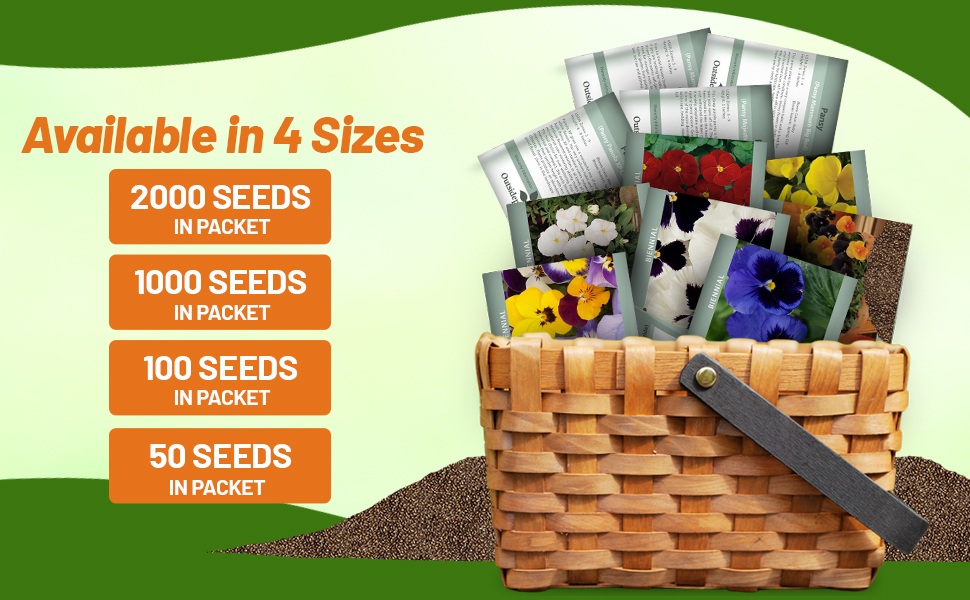
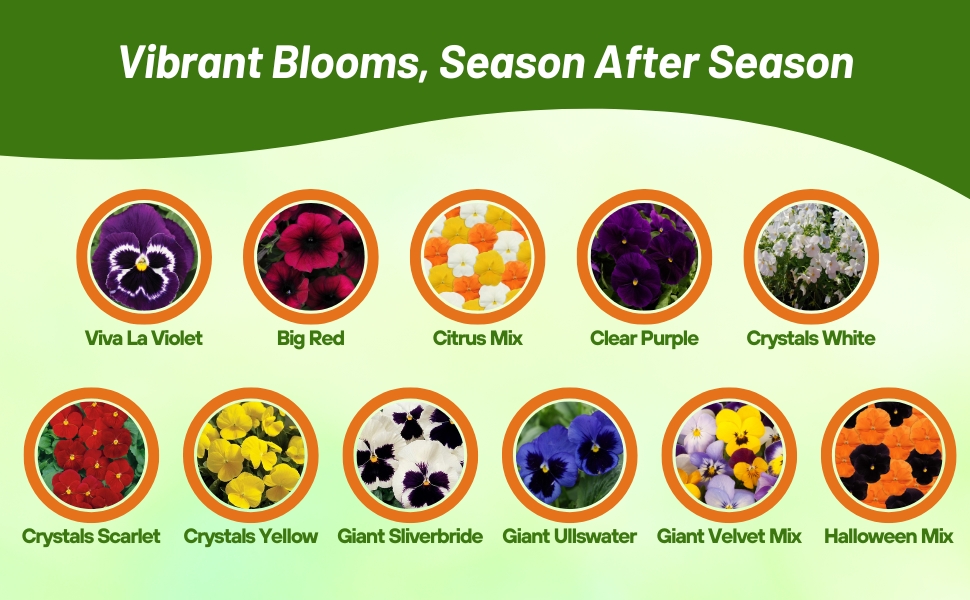


Pansy (Pansy Mammoth Viva La Violet) - This Pansy series is called "Mammoth" for a reason. Larger, more tolerant and stronger, this new pansy series is the most uniform in an XL-pansy series. Viva La Violet Pansies branch quickly to fill a container or pot. If you are looking for robust garden performance and large flowers this pansy plant will give you just that. These Pansies were bred for stronger roots that will establish quickly in your home garden from pansy seeds. The flower seeds are not pelleted, but are raw and primed.
Common Questions
Are pansies edible?
Yes, they have a mild minty taste and may be eaten fresh as a garnish or candied for decorating cakes.
Why do my pansies stop blooming in the summer?
Hot weather will cause pansies to fade and die out.
Why are my pansies spindly?
Check to see if your plants are overcrowded, pansies need to be spaced 6 inches apart. Make sure they are getting enough light especially when starting seeds inside.
Should pansies be deadheaded?
Yes, to encourage a longer bloom season you will need to deadhead your flowers. This will also keep the flowers from dropping seeds.
When do pansies bloom?
Pansies bloom in the fall and in spring into early summer when the weather is cool.
Do pansies grow better in containers or in the ground?
Pansies flourish in both pots and raised beds. Because they have shallow roots, it's important not to plant them too deeply in dense soil. Always opt for well-draining soil for beds and a light potting mix for containers, ensuring that the containers also have drainage holes.
Planting Directions
TEMPERATURE
65 - 70F
AVERAGE GERM TIME
7 - 14 days
LIGHT REQUIRED
No
DEPTH
Cover seed lightly with peat moss
SOWING RATE
3 - 4 seeds per plant
MOISTURE
Keep seeds moist until germination
PLANT SPACING
8 - 12 inches
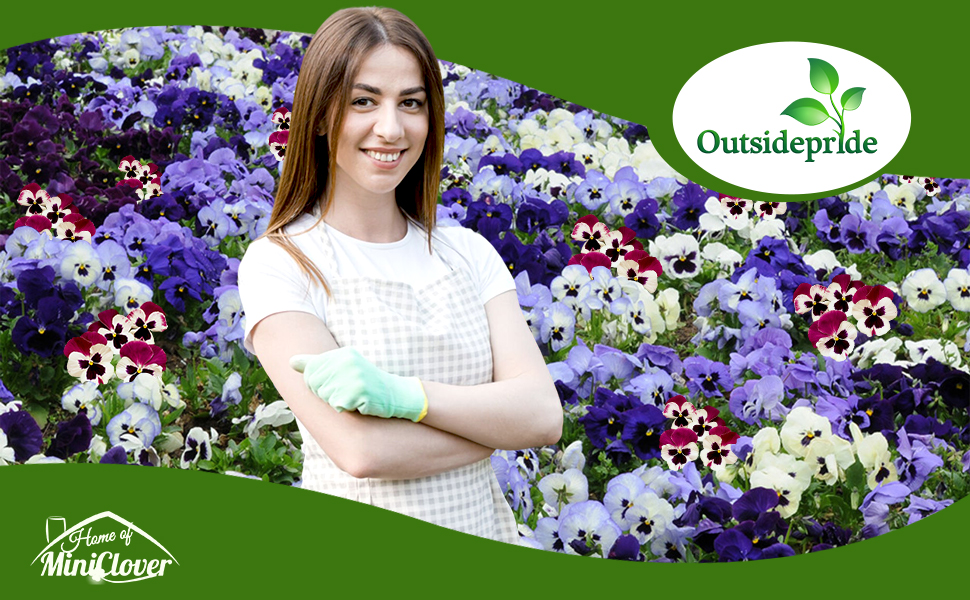
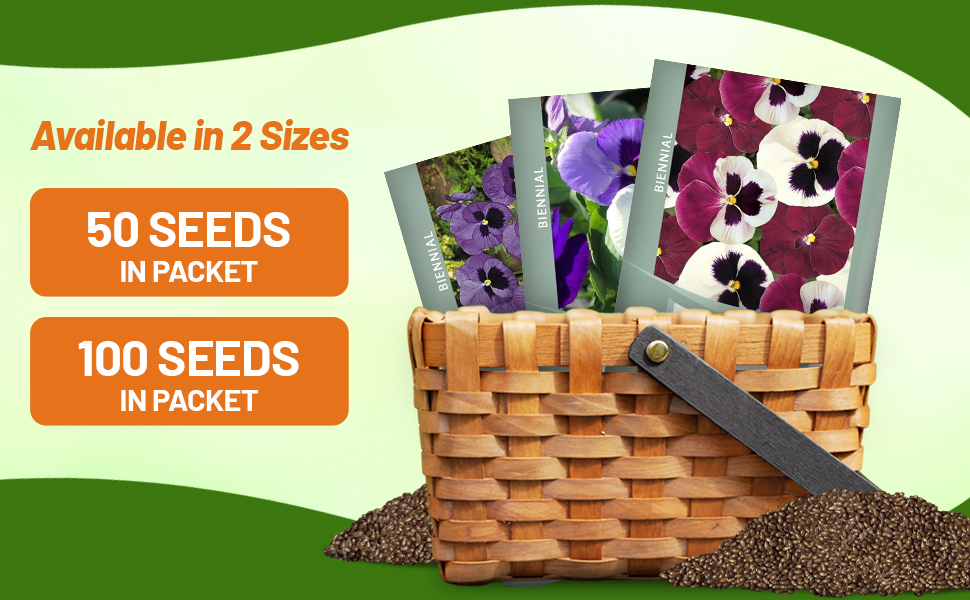
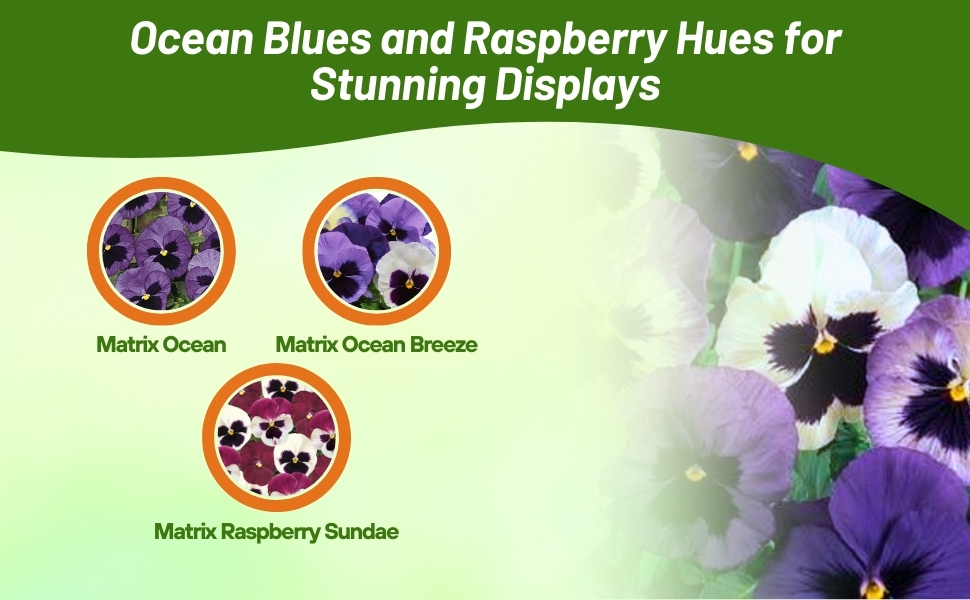
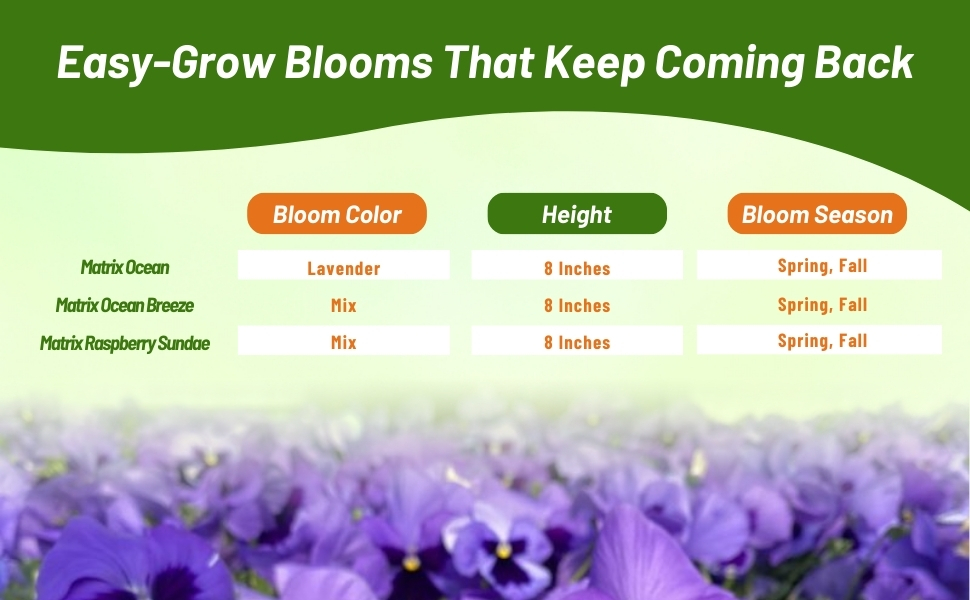
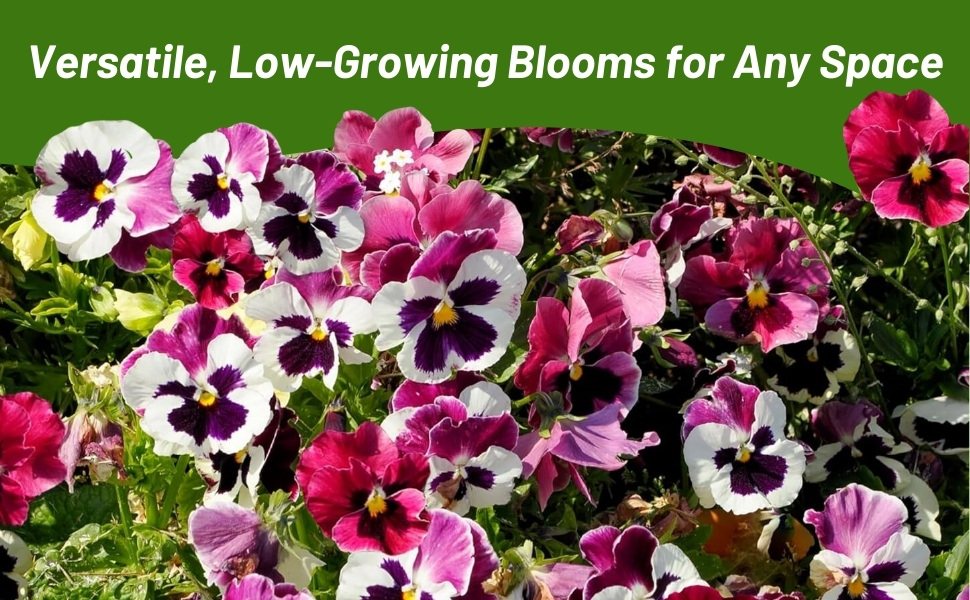
Pansy (Pansy Matrix Ocean) - For quick germination, this seed is raw and primed. Pansy Matrix is your best option for longer days and warmer growing. Beautiful lavender like blossoms load up these hardy pansy plants that only grow 8 inches tall. Shades of light lavender blue with blotch; can contain a small percentage of white with blotch depending on environment.
Common Questions
Are pansies edible?
Yes, they have a mild minty taste and may be eaten fresh as a garnish or candied for decorating cakes.
Why do my pansies stop blooming in the summer?
Hot weather will cause pansies to fade and die out.
Why are my pansies spindly?
Check to see if your plants are overcrowded, pansies need to be spaced 6 inches apart. Make sure they are getting enough light especially when starting seeds inside.
Should pansies be deadheaded?
Yes, to encourage a longer bloom season you will need to deadhead your flowers. This will also keep the flowers from dropping seeds.
When do pansies bloom?
Pansies bloom in the fall and in spring into early summer when the weather is cool.
Do pansies grow better in containers or in the ground?
Pansies flourish in both pots and raised beds. Because they have shallow roots, it's important not to plant them too deeply in dense soil. Always opt for well-draining soil for beds and a light potting mix for containers, ensuring that the containers also have drainage holes.
Planting Directions
TEMPERATURE
65 - 70F
AVERAGE GERM TIME
7 - 14 days
LIGHT REQUIRED
No
DEPTH
Cover seed lightly with peat moss
SOWING RATE
3 - 4 seeds per plant
MOISTURE
Keep seeds moist until germination
PLANT SPACING
8 - 12 inches
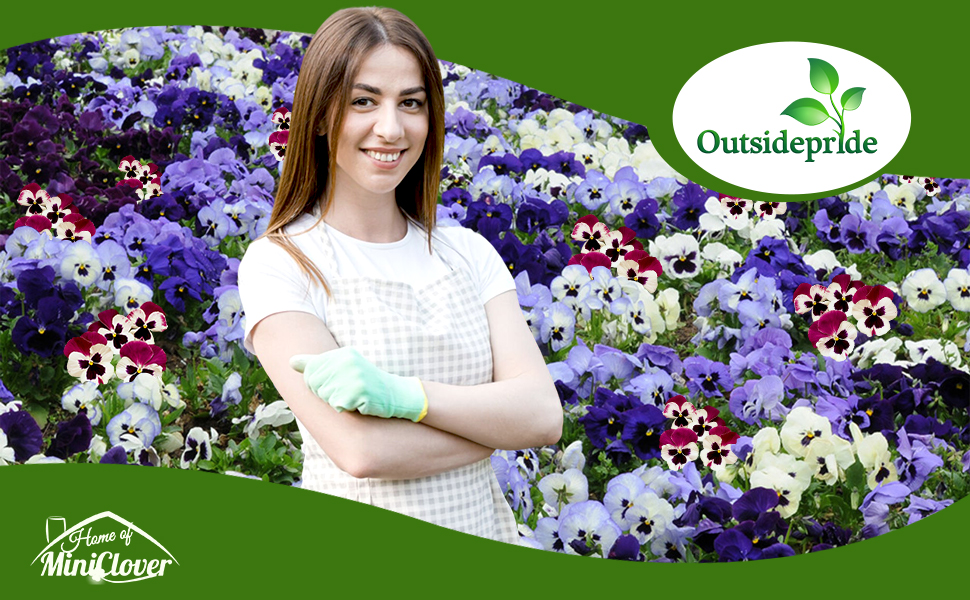

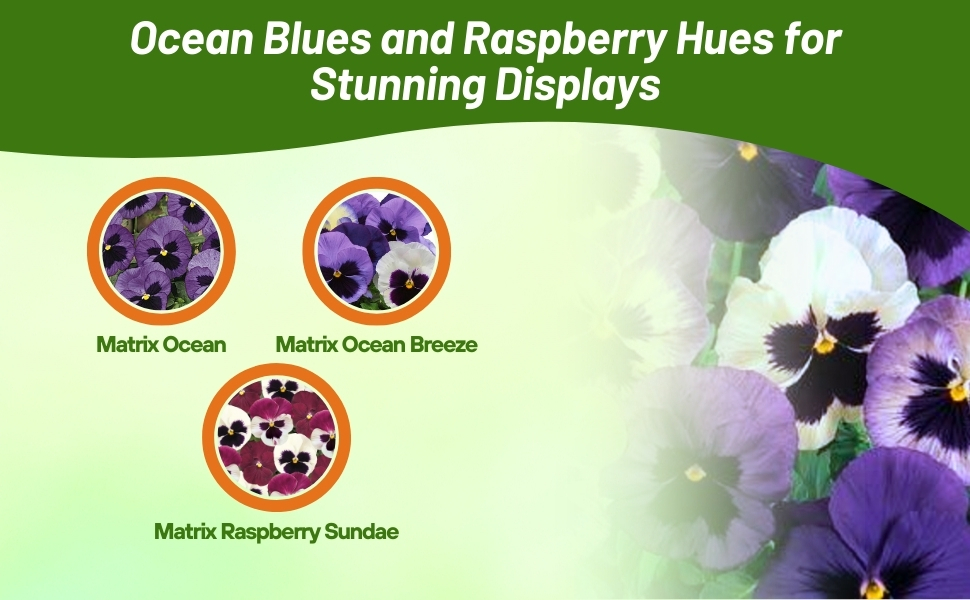
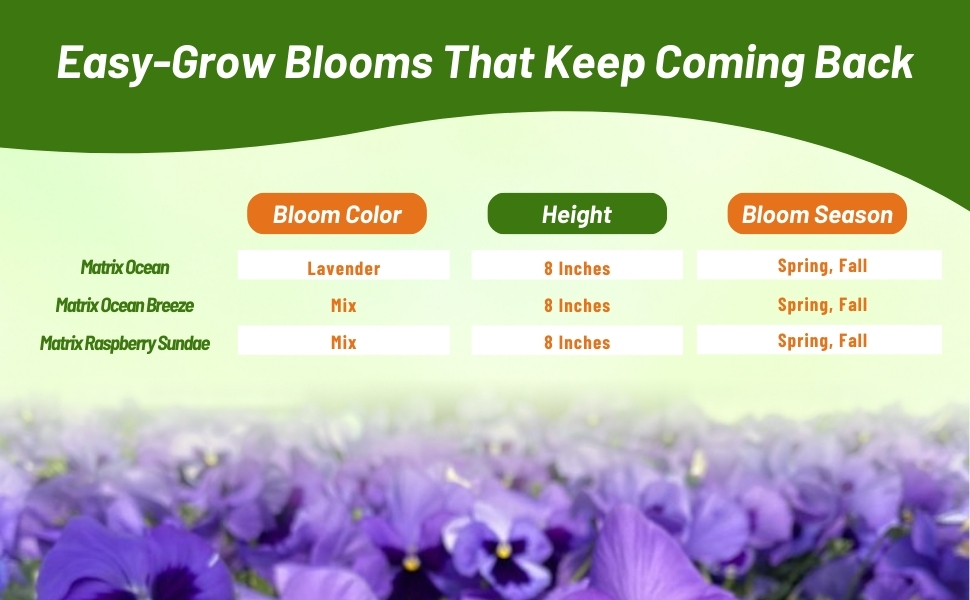

Pansy (Pansy Matrix Ocean Breeze Mix) - Pansy Matrix is your best option for longer days and warmer growing. This Ocean Breeze pansy seed mix contains: Blue Frost, Deep Blue Blotch, Ocean and White Blotch pansy seeds. These flower seeds are raw and primed and germinate very quickly.
Common Questions
Are pansies edible?
Yes, they have a mild minty taste and may be eaten fresh as a garnish or candied for decorating cakes.
Why do my pansies stop blooming in the summer?
Hot weather will cause pansies to fade and die out.
Why are my pansies spindly?
Check to see if your plants are overcrowded, pansies need to be spaced 6 inches apart. Make sure they are getting enough light especially when starting seeds inside.
Should pansies be deadheaded?
Yes, to encourage a longer bloom season you will need to deadhead your flowers. This will also keep the flowers from dropping seeds.
When do pansies bloom?
Pansies bloom in the fall and in spring into early summer when the weather is cool.
Do pansies grow better in containers or in the ground?
Pansies flourish in both pots and raised beds. Because they have shallow roots, it's important not to plant them too deeply in dense soil. Always opt for well-draining soil for beds and a light potting mix for containers, ensuring that the containers also have drainage holes.































